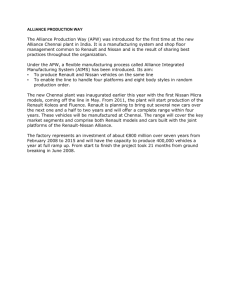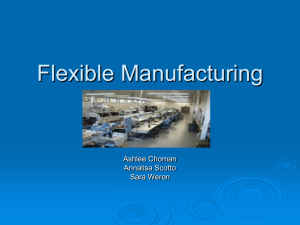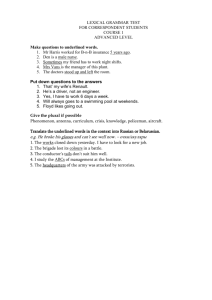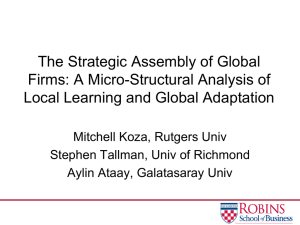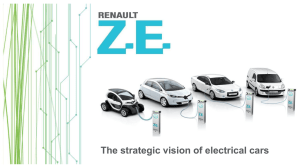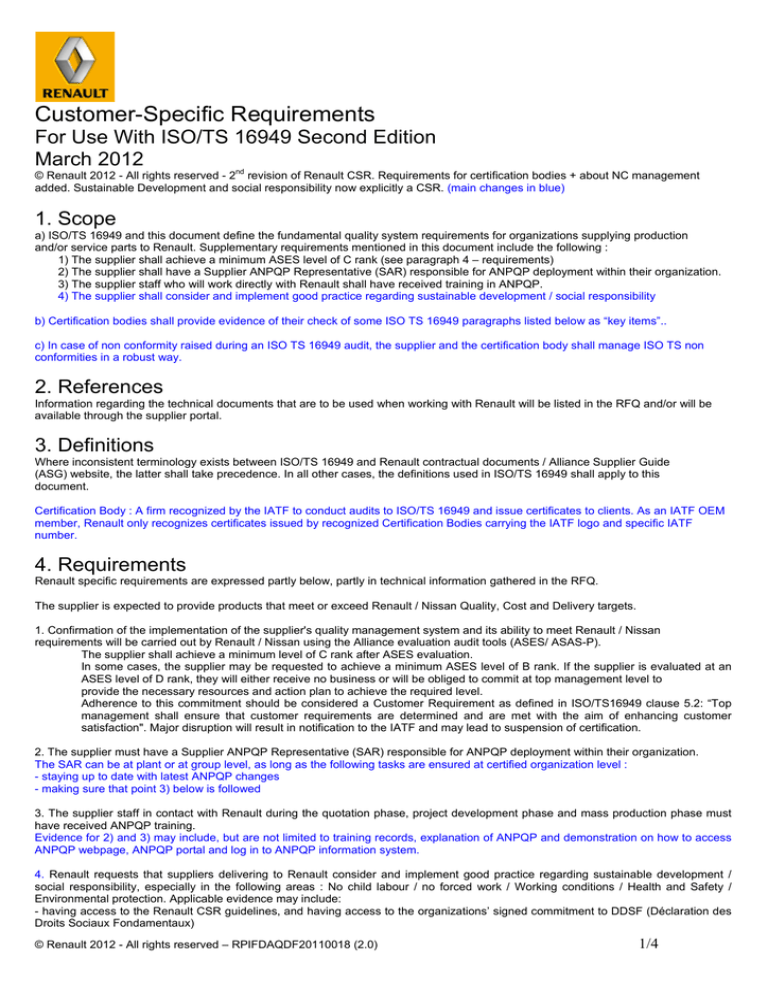
Customer-Specific Requirements
For Use With ISO/TS 16949 Second Edition
March 2012
© Renault 2012 - All rights reserved - 2nd revision of Renault CSR. Requirements for certification bodies + about NC management
added. Sustainable Development and social responsibility now explicitly a CSR. (main changes in blue)
1. Scope
a) ISO/TS 16949 and this document define the fundamental quality system requirements for organizations supplying production
and/or service parts to Renault. Supplementary requirements mentioned in this document include the following :
1) The supplier shall achieve a minimum ASES level of C rank (see paragraph 4 – requirements)
2) The supplier shall have a Supplier ANPQP Representative (SAR) responsible for ANPQP deployment within their organization.
3) The supplier staff who will work directly with Renault shall have received training in ANPQP.
4) The supplier shall consider and implement good practice regarding sustainable development / social responsibility
b) Certification bodies shall provide evidence of their check of some ISO TS 16949 paragraphs listed below as “key items”..
c) In case of non conformity raised during an ISO TS 16949 audit, the supplier and the certification body shall manage ISO TS non
conformities in a robust way.
2. References
Information regarding the technical documents that are to be used when working with Renault will be listed in the RFQ and/or will be
available through the supplier portal.
3. Definitions
Where inconsistent terminology exists between ISO/TS 16949 and Renault contractual documents / Alliance Supplier Guide
(ASG) website, the latter shall take precedence. In all other cases, the definitions used in ISO/TS 16949 shall apply to this
document.
Certification Body : A firm recognized by the IATF to conduct audits to ISO/TS 16949 and issue certificates to clients. As an IATF OEM
member, Renault only recognizes certificates issued by recognized Certification Bodies carrying the IATF logo and specific IATF
number.
4. Requirements
Renault specific requirements are expressed partly below, partly in technical information gathered in the RFQ.
The supplier is expected to provide products that meet or exceed Renault / Nissan Quality, Cost and Delivery targets.
1. Confirmation of the implementation of the supplier's quality management system and its ability to meet Renault / Nissan
requirements will be carried out by Renault / Nissan using the Alliance evaluation audit tools (ASES/ ASAS-P).
The supplier shall achieve a minimum level of C rank after ASES evaluation.
In some cases, the supplier may be requested to achieve a minimum ASES level of B rank. If the supplier is evaluated at an
ASES level of D rank, they will either receive no business or will be obliged to commit at top management level to
provide the necessary resources and action plan to achieve the required level.
Adherence to this commitment should be considered a Customer Requirement as defined in ISO/TS16949 clause 5.2: “Top
management shall ensure that customer requirements are determined and are met with the aim of enhancing customer
satisfaction". Major disruption will result in notification to the IATF and may lead to suspension of certification.
2. The supplier must have a Supplier ANPQP Representative (SAR) responsible for ANPQP deployment within their organization.
The SAR can be at plant or at group level, as long as the following tasks are ensured at certified organization level :
- staying up to date with latest ANPQP changes
- making sure that point 3) below is followed
3. The supplier staff in contact with Renault during the quotation phase, project development phase and mass production phase must
have received ANPQP training.
Evidence for 2) and 3) may include, but are not limited to training records, explanation of ANPQP and demonstration on how to access
ANPQP webpage, ANPQP portal and log in to ANPQP information system.
4. Renault requests that suppliers delivering to Renault consider and implement good practice regarding sustainable development /
social responsibility, especially in the following areas : No child labour / no forced work / Working conditions / Health and Safety /
Environmental protection. Applicable evidence may include:
- having access to the Renault CSR guidelines, and having access to the organizations’ signed commitment to DDSF (Déclaration des
Droits Sociaux Fondamentaux)
© Renault 2012 - All rights reserved – RPIFDAQDF20110018 (2.0)
1/4
- 2nd party evaluation (for example, customer evaluation)
- 3rd party evaluation, such as ISO 26000 evaluation, OHSAS 18001 / ISO14000 certification,
Any other system demonstrating that sustainable development / social responsibility concerns are taken seriously by the organization
will be accepted.
b) The certification body shall include in their report detailed feedback of their checks of the items listed as key items in paragraph 5 /
“focus on key items”.
c). In case of non conformity during the ISO TS 16949 audit, the supplier and the certification body must manage ISO TS non
conformities in a robust way. The table below lists the respective “shalls”
Step
Finding description
Requirement for the supplier
Findings shall be formally acknowledged by plant
manager AND quality manager. (signature).
Supplier should reserve 0,5 to 1 day right after the
audit to start asap the corrective process, starting
with the root cause analysis, should there be any NC.
Definition of effectiveness
(What will be the evidence of
effectiveness of corrective
actions : Define target and how
to measure it (what, when))
Root cause analysis
Define SYSTEMIC
corrective actions linked to
previous analysis :
It shall be formally defined, preferably with quantified
figures or as a binary result, such as proof or
eradication of the systemic root causes. This
effectiveness definition shall be formalized and
communicated to CB jointly with the root cause
analysis and prior to the action plan.
It shall be documented with a deep analysis for
occurrence, non detection and systemic cause of
non-conformity. Each type of cause shall be studied
down to the root cause thanks to quality tools such as
combined Ishikawa and 5 why.
Causes should be at organization / management
level and not related to individuals.
The first 3 steps should be conducted within 21 days.
They shall be formally approved by plant manager
AND quality manager
Action plan shall address root causes and shall
ensure that there will not be recurrence of the non
conformity where it was found as well as in similar
areas where countermeasures shall reasonably be
applied.
Requirement for the certification body (CB)
The CB shall state several examples or
preferably the extent of failure of the system.
(number of cases out of number of examples
picked / ratio of Not OK with respect to scope of
system, continuously low performance).
The CB should describe the risk associated to
this finding (for its customer, the OEM, the final
customer)
Relevance of effectiveness definition shall be
validated. Corresponding documents shall be
saved as part of the file.
Note : ability to conduct root cause analysis has
been validated by CB by item 8.5.2.1.
There is no excuse to accept a lame analysis at
the same time.
Detailed analysis shall be saved as part of the
file.
The CB shall validate the relevance of the action
plan and the link to the root cause analysis.
Action plan shall be formally validated by plant
manager AND quality manager (signature, paper or
electronic).
CB should give feedback before 45th day
Completion, effectiveness
and
maintenance
of
effectiveness
for
each
action
Global effectiveness
This step should be conducted within 35 days max.
It shall be submitted as part of the file, separately for
each action previously mentioned in the action plan
It shall be formally assessed with respect to the
effectiveness criteria as defined in corresponding
step
100% solved
Change of status following
a Non Conformity or a
complaint.
All requested evidence shall be validated, then
saved as part of the file (as requested by IATF
rules).
The 100% solved status was originally created to
address the rare cases where the actions could
not possibly be completed within 90 days.
If some non-conformities are solved using this
status, explain why and define current status of
action plan completion and new date to send /
collect further evidence of achievement and
effectiveness as soon as possible.
If nonconformity is not solved according to IATF rules
and leads to change of certificate status, supplier
shall notify Renault of their change of status.
(mail to qualite.achats@renault.com and usual
Purchasing Department contacts – buyer and SAM)
© Renault 2012 - All rights reserved – RPIFDAQDF20110018 (2.0)
2/4
5. Additional Information regarding Renault position vs ISO TS 16949:2009
Focus on key items
Renault has limited its number of specific requirements because the ISO TS 16949 standard itself is comprehensive.
For Renault, the key concepts of the ISO TS 16949 are customer satisfaction as well as self-improvement through efficient
problem solving and continuous improvement. All tasks achieved / documents used within this frame should serve these goals :
acceptance of a document by an OEM is not a waiver.
A study of past quality problems and 2nd party system audits has led Renault to highlight some areas requested by the ISO/TS
16949 standard, for which confirmation of the existence of documented evidence is highly recommended. These are :
Item
7.1.4 Change
control
7.3.4
Design and
development
review
7.5.1.3
Verification of
job set-ups
8.3 Control of
nonconforming
product
Whole paragraph, including the note, starting with
‘The organization shall have a process to control and react to changes that
impact product realization. The effects of any change, including those
changes caused by any supplier, shall be assessed, and verification and
validation activities shall be defined, to ensure compliance with customer
requirements. Changes shall be validated before
implementation.(…)
At suitable stages, systematic reviews of design and development shall be
performed (…). Records of the results of the reviews and any necessary
actions shall be maintained.
Evidence of risk analysis should be
documented
Job set-ups shall be verified whenever performed, such as an initial run of a
job, material changeover or job change.
Evidence of verification should be
accessible
The organization shall ensure that product which does not conform to
product requirements is identified and controlled to prevent its unintended
use or delivery
The ergonomics and the robustness
of the method used have to be
considered when evaluating
conformance to clause 8.3
8.3 Control of
nonconforming
product
(..)When nonconforming product is corrected it shall be subject to reverification to demonstrate conformity to the requirements.
8.3.2 Control
of reworked
product
8.5.2.1
Problem
solving
Instructions for rework, including re-inspection requirements, shall be
accessible to and utilized by the appropriate
Personnel
The organization shall have a defined process for problem solving leading to
root cause identification and elimination.
8.5.2.3
Corrective
action impact
The organization shall apply to other similar processes and products the
corrective action, and controls implemented, to eliminate the cause of a
nonconformity.
Documented evidence is necessary
7.3.6.3 Product
approval
process
The organization shall conform to a product and manufacturing process
approval procedure recognized by the customer.
NOTE Product approval should be subsequent to the verification of the
manufacturing process.[…]
Note that it is the organization
responsibility
to
ensure
the
verification of its process, regardless
of the customer approval.
Problem solving must be thorough enough
to solve the problems.
Acceptance of a problem solving file by a
customer is no waiver for a poor
analysis, as the ultimate goal of the
analysis should be for the
organization itself to solve its
problem
Renault and the core tools
FMEA
MSA
APQP
The use of FMEA (according to AIAG Manual, latest version) is widely accepted.
The use of Renault AMDEC is recommended in accordance with standard 01-33-200. (accessible through Renault
supplier portal – GD norms);
The Supplier’s own standard is accepted.
Whenever requested by Renault, a Product, Process or Means FMEA / AMDEC shall be submitted for verification and
validation.
FMEA should be a living document, used to evaluate risks and therefore updated regularly along with the latest
changes (7.1.4)
The use of MSA is accepted. However the use of the CNOMO standard or Renault specific methods are
recommended.
As part of purchasing contracts, Renault requests the use of ANPQP .
“. The supplier is required to rigorously apply ANPQP to identify all reasonably foreseeable potential safety issues and
to take preventative actions to ensure that such safety issues do not occur during the use of the product”.
The structure of ANPQP is similar to the structure of the AIAG APQP document. This has been done to facilitate
understanding of ANPQP
Note : Though not forbidden, a detailed check of an ANPQP folder is not requested from the certification bodies
© Renault 2012 - All rights reserved – RPIFDAQDF20110018 (2.0)
3/4
PPAP
SPC
The equivalent for Renault of the “Production Part Approval Process” is the ANPQP (“Alliance New Product Quality
Procedure”).
The equivalent for Renault of the “PPAP submission” or “PPAP package” is the PSW (Part Submission Warrant).
This link between PPAP and ANPQP / PSW is for explanation purpose only.
Capabilities: Renault accepts the use of capabilities according to AIAG manual, but recommends the use of
Renault internal methods and targets.
Control charts : Renault accepts the use of control charts and rules for reaction as defined in the AIAG manual.
The basic principles of control charts should be considered, including
control limits are not tolerance ranges, and should be calculated according to usual SPC rules
In case a need for reaction is identified, according to chosen SPC common sense rule, the reaction
should be conducted, recorded, and its result confirmed with documented evidence.
Notification to certification bodies
Status
Ppm Alarm level 2
Ppm Alarm level 3
Blockage
ASES
D
rank
and
commitment not adhered to
ASES D rank for an
organization
seeking
certification
to
ISO/TS
16949:2009
Notification to CB
Renault reserves the right to notify the Certification Body, according to IATF rules, after detecting a
serious quality problem such as repetitive car blockages, recall campaigns, recurrence of Quality
alarms, weak ASES results or insufficient involvement in Rank Up activities. These situations may also
lead to a Business Hold by Renault.
© Renault 2012 - All rights reserved – RPIFDAQDF20110018 (2.0)
4/4

